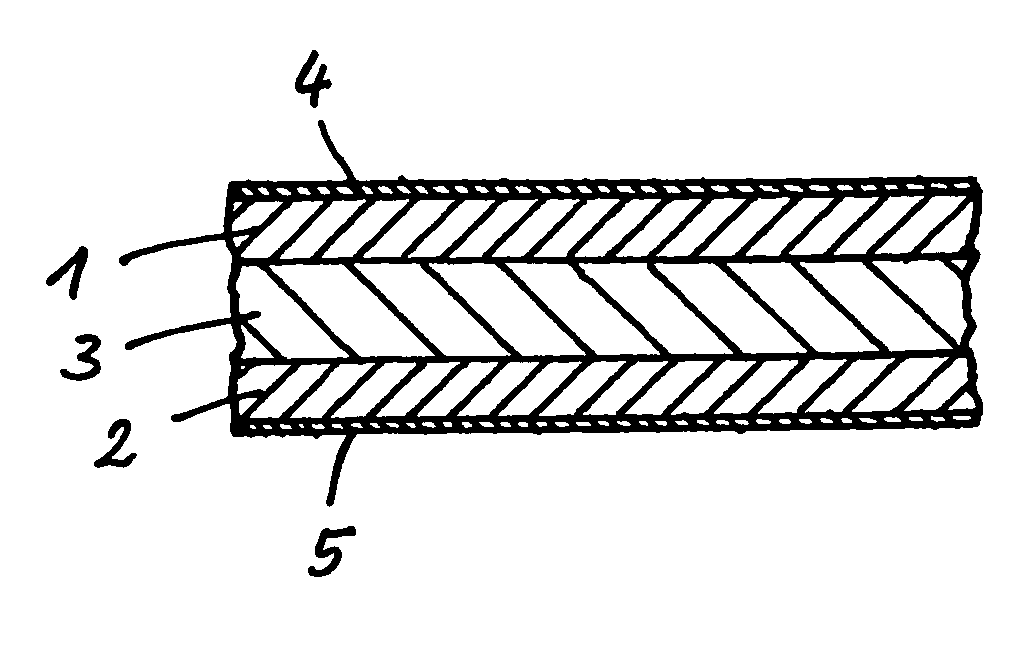Elastomer-bonded sheet material and process for its production
- Summary
- Abstract
- Description
- Claims
- Application Information
AI Technical Summary
Benefits of technology
Problems solved by technology
Method used
Image
Examples
example 1
Composition 1 With Exclusively an R Rubber as Matrix
[0022]The following raw materials were mixed to give a homogeneous mass of crumb in a turbular mixer.[0023]13–17 parts of R rubber; in this case nitrile-butadiene rubber[0024]38–45 parts of kaolin[0025]3–8 parts of precipitated silica[0026]5–9 parts of para-aramid fibre[0027]25–30 parts of glass fibre[0028]2–3 parts of sulphur-based vulcanization additives, composed of sulphur, activator, accelerator, co-activators and processing aids
The NBR was dissolved during the mixing process, using 28–33 parts (based on the total amount of dry substance) of toluene.
example 2
Composition 2 With a Blend Composed of R and M Rubber or Partially Hydrogenated R Rubbers as Matrix
[0029]The following raw materials were mixed to give a homogeneous mass of crumb in a turbular mixer.[0030]6.5–8.5 parts of R rubber; nitrile-butadiene rubber[0031]6.5–8.5 parts of M rubber or rubber with [0032]38–45 parts of kaolin[0033]3–8 parts of precipitated silica[0034]5–9 parts of para-aramid fibre[0035]25–30 parts of glass fibre[0036]2–3 parts of sulphur-based vulcanization additives, composed of sulphur, sulphur donor, activator, accelerator, co-activators and processing aids
[0037]Both elastomers were dissolved during the mixing process, using 28–33 parts (based on the total amount of dry substance) of toluene.
example 3
Composition 3 with Exclusively an M Rubber or a Partially Hydrogenated R Rubber as Matrix
[0038]The following raw materials were mixed to give a homogeneous mass of crumb in a turbular mixer.[0039]13–17 parts of M rubber; or rubber with [0040]38–45 parts of kaolin[0041]3–8 parts of precipitated silica[0042]5–9 parts of para-aramid fibre[0043]25–30 parts of glass fibre[0044]2–3 parts of sulphur-based vulcanization additives, composed of sulphur, sulphur donor, activator, accelerator, co-activators and processing aids
The HNBR was dissolved during the mixing process, using 28–33 parts (based on the total amount of dry substance) of toluene.
Example of Production of Sample Sheets
[0045]A two-roll vertical calender according to FIG. 2 was used to produce sample sheets.
[0046]The roll 6 heated with high-pressure water was heated to 180±5° C. surface temperature. The circumference of the roll 6 was 4060 mm and its width was 1560 mm. The cooling roll 7 was cooled by means of cooling water to a ...
PUM
| Property | Measurement | Unit |
|---|---|---|
| Length | aaaaa | aaaaa |
| Length | aaaaa | aaaaa |
| Fraction | aaaaa | aaaaa |
Abstract
Description
Claims
Application Information
 Login to View More
Login to View More - R&D
- Intellectual Property
- Life Sciences
- Materials
- Tech Scout
- Unparalleled Data Quality
- Higher Quality Content
- 60% Fewer Hallucinations
Browse by: Latest US Patents, China's latest patents, Technical Efficacy Thesaurus, Application Domain, Technology Topic, Popular Technical Reports.
© 2025 PatSnap. All rights reserved.Legal|Privacy policy|Modern Slavery Act Transparency Statement|Sitemap|About US| Contact US: help@patsnap.com


